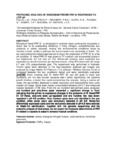Por favor, use este identificador para citar o enlazar este ítem:
http://www.alice.cnptia.embrapa.br/alice/handle/doc/1045758| Título: | Proteomic analysis of Rhizobium freirei PRF 81 responses to low pH. |
| Autor: | TULLIO, L. D.  PAULITSCH, F.   REICHERT, P. R. S.   KLEPA, M. S.   KLEPA, M. S.   PILEGGI, M.   GOMES, D. F.   HUNGRIA, M.   BATISTA, J. S. S.   |
| Afiliación: | UEPG; UEPG; UEPG; UEPG; UEPG; MARIANGELA HUNGRIA DA CUNHA, CNPSO; UEPG. |
| Año: | 2015 |
| Referencia: | In: CONGRESSO BRASILEIRO DE MICROBIOLOGIA, 28.; SIMPÓSIO DE FERMENTAÇÃO ALCOÓLICA, 3.; SIMPÓSIO DE MICRORGANISMOS FOTOSSINTETIZANTES, 3.; SIMPÓSIO DE ESCHERICHIA COLI LUIZ RACHID TRABULSI, 4., 2015, Florianópolis. Anais... [São Paulo]: Sociedade Brasileira de Microbiologia, 2015. |
| Descripción: | Rhizobium freirei PRF 81 is employed in common bean commercial inoculants in Brazil, due to its outstanding efficiency in fixing nitrogen, competitiveness and tolerance to abiotic stresses. Among the environmental conditions faced by rhizobia in soils, acidity is perhaps the encountered most, especially in Brazil. So, we used proteomics based approaches to study the responses of PRF 81 to a low pH condition. R. freirei PRF 81 was grown in TY medium until exponential phase in two treatments: pH 6,8 and pH 4,8. Whole-cell proteins were extracted and separated by two-dimensional gel electrophoresis, using IPG-strips with pH range 4-7 and 12% polyacrilamide gels. The experiment was performed in triplicate. Protein spots were detected in the high-resolution digitized gel images and analyzed by Image Master 2D Platinum v 5.0 software. Relative volumes (%vol) of compared between the two conditions tested and were statistically evaluated (p ≤ 0.05). Even knowing that R. freirei PRF 81 can still grow in more acid conditions, pH 4.8 was chosen because didn´t affect significantly the bacterial growth kinetics, a factor that could compromise the analysis. Using a narrow pH range, the gel profiles displayed a better resolution and reprodutibility than using broader pH range. Spots were mostly concentrated between pH 5-7 and molecular masses between 17-95 kDa. From the six hundred well-defined spots analyzed, one hundred and sixty-three spots presented a significant change in % vol, indicating that the pH led to expressive changes in the proteome of R. freirei PRF 81. Of these, sixty-one were up-regulated and one hundred two was downregulated in pH 4.8 condition. Also, fourteen spots were only identified in the acid condition, while seven spots was exclusively detected in pH 6.8. Ninety-five differentially expressed spots and two exclusively detected in pH 4,8 were selected for Maldi-Tof identification. Together with the genome sequencing and the proteome analysis of heat stress, we will search for molecular determinants of PRF 81 related to capacity to adapt to stressful tropical conditions. |
| Thesagro: | Fixação de nitrogênio |
| NAL Thesaurus: | Nitrogen fixation |
| Notas: | Res. 1407-2. |
| Tipo de Material: | Resumo em anais e proceedings |
| Acceso: | openAccess |
| Aparece en las colecciones: | Resumo em anais de congresso (CNPSO)  |
Ficheros en este ítem:
| Fichero | Descripción | Tamaño | Formato | |
|---|---|---|---|---|
| R14072.PDF | 110.08 kB | Adobe PDF |  Visualizar/Abrir |









